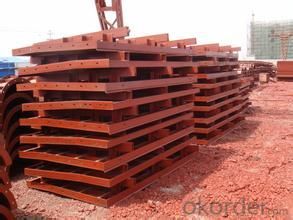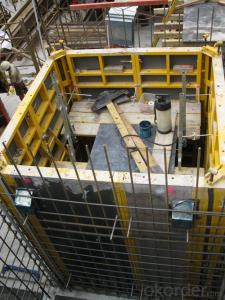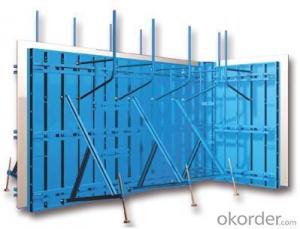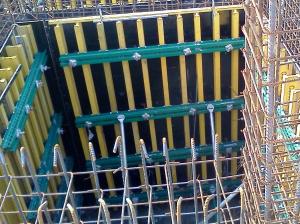Steel Fram Formworks for in Different Kinds of Construction China Market
- Loading Port:
- Shanghai
- Payment Terms:
- TT OR LC
- Min Order Qty:
- 1 m²
- Supply Capability:
- 100000 m²/month
OKorder Service Pledge
OKorder Financial Service
You Might Also Like
1. Structure of Steel Frame Formwork GK120 Description
There is a prizing part designed in the corner, which can help to position and remove formwork easily.The plywood is screwed on from the back when connecting frame and plywood, so the surface of the finished concrete is perfect.The formwork series are a complete system with a full set of accessories, and can be set up flexibly according to project demand.
2. Main Features of Steel Frame Formwork GK120
-convenient for construction
-easy to control the quality
-easy, rapid and economical.
3. Steel Frame Formwork GK120 Images

4. Steel Frame Formwork GK120Specifications
Steel Frame Formwork GK120 is used for the concrete pouring of square or rectangle column. The system has the same structure and similar connection type with wall formwork.
5. FAQ OF Steel Frame Formwork GK120
1) What can we do for you?
.We can ensure the quality of the Steel Frame Formwork GK120 and avoid extra expenses for customers.
.We can provide you the professional technical team.
.We can provide professional building proposal for your projects.
2) What promises can be done by us?
. If interested in this kind of formwork, please feel free to write us for any QUOTE.
. If need any technical and building assistance, we could provide on-site professional staff for instruction.
. Please DO check goods when courier knocks your door and contact us asap if any issueS.
3) What about of our after-sale services?
. Response will be carried out in 24hours after receiving any complain or request.
. Any formwork cost can be refund after order is confirmed.
. If the products are not based on the requirements, there will be the relevant compensations made for you.
4) What about the package and shipping time?
.Packing: wood package and adhesive tape
.Shipping: by sea
Shipping time: Normally small orders, it just1week business days to arrive your hand; When comes to the customs declaration, it may need 2weeks.
- Q: Are there any specific requirements for bracing steel frame formwork?
- Bracing steel frame formwork necessitates adhering to specific requirements to guarantee the stability and safety of the structure throughout the construction process. To begin with, it is crucial to possess a comprehensive comprehension of the design and structural requisites of the steel frame formwork system. This encompasses understanding the load-bearing capacity, maximum formwork height and width, and the bracing specifications provided by the manufacturer or structural engineer. The bracing system must be designed to withstand lateral loads and forces that could impact the formwork during concrete pouring and curing. This includes wind loads, pressure from the wet concrete, and any other potential forces encountered on the construction site. In order to ensure stability and prevent formwork movement or collapse, the bracing should be firmly anchored either to the ground or other structural elements. The anchoring method employed should be suitable for site-specific conditions and take into consideration factors such as soil type, foundation strength, and potential lateral forces. Regular inspection and maintenance of the bracing system is also of utmost importance to ensure its effectiveness throughout the construction process. This entails checking for any indications of damage, corrosion, or weakening of bracing components, and promptly addressing any identified issues. In conclusion, the specific requirements for bracing steel frame formwork encompass a comprehensive understanding of design and structural requisites, designing the bracing to withstand lateral loads, secure anchoring of the bracing system, and regular inspection and maintenance of bracing components. By fulfilling these requirements, the stability and safety of the steel frame formwork during construction can be assured.
- Q: Can steel frame formwork be used for both interior and exterior beam construction?
- Steel frame formwork is a versatile and robust system that can be used for both interior and exterior beam construction. Its strength and durability make it suitable for various construction projects, including beam construction. Furthermore, steel frame formwork offers flexibility in terms of shape and size, allowing for the construction of beams of different dimensions and designs. It is also easy to assemble and disassemble, which makes it a convenient choice for both interior and exterior beam construction. In summary, steel frame formwork is a reliable and efficient solution for beam construction, regardless of the location.
- Q: Can steel frame formwork be integrated with other construction systems?
- Yes, steel frame formwork can be integrated with other construction systems. It is a versatile system that can be easily adapted and combined with various construction methods and materials, allowing for efficient and effective construction processes.
- Q: Can steel frame formwork be used for both straight and curved walls?
- Yes, steel frame formwork can be used for both straight and curved walls. Steel frame formwork is highly versatile and can easily be adjusted to create various shapes and sizes. It is designed to provide stability and support during the concrete pouring process, ensuring that the walls are formed accurately and with precision. The steel frame formwork can be easily manipulated to create both straight and curved walls, making it a suitable choice for various construction projects.
- Q: What are the different types of formwork systems that can be used in conjunction with steel frame formwork?
- There are several different types of formwork systems that can be used in conjunction with steel frame formwork. These include: 1. Timber formwork: Timber formwork is one of the most commonly used formwork systems. It involves using timber boards or plywood to create the formwork structure. Timber formwork is versatile, cost-effective, and easy to work with. It is suitable for a wide range of concrete structures, including walls, columns, beams, and slabs. 2. Aluminum formwork: Aluminum formwork is a lightweight and durable formwork system. It consists of aluminum panels that are connected together to create the formwork structure. Aluminum formwork is known for its high strength-to-weight ratio, which allows for faster construction and reduced labor costs. It is commonly used for repetitive structures like residential buildings and commercial complexes. 3. Plastic formwork: Plastic formwork is a relatively newer formwork system that is gaining popularity due to its versatility and ease of use. It is made of lightweight and durable plastic panels that can be easily assembled and disassembled. Plastic formwork is suitable for a wide range of concrete structures, including walls, columns, and slabs. It offers advantages such as lower labor costs, reduced formwork waste, and improved construction speed. 4. Fiberglass formwork: Fiberglass formwork is a lightweight and high-strength formwork system. It is made of fiberglass panels that are capable of withstanding high concrete pressures. Fiberglass formwork is suitable for a variety of concrete structures, including walls, columns, beams, and slabs. It offers advantages such as easy handling, reduced labor costs, and improved construction speed. 5. Modular formwork: Modular formwork refers to a system where standardized formwork components are used to create various formwork configurations. It can be used in conjunction with steel frame formwork by integrating the steel frames with the modular formwork components. Modular formwork is highly flexible and can be adjusted to suit different construction requirements. It is suitable for complex structures and can be easily reused, making it a cost-effective option. Overall, these different types of formwork systems offer a range of advantages, such as versatility, cost-effectiveness, ease of use, and increased construction speed. The choice of formwork system will depend on factors such as the construction project's requirements, budget, and timeline.
- Q: Can steel frame formwork be used in high-rise construction projects?
- Yes, steel frame formwork can be used in high-rise construction projects. Steel frame formwork is a versatile and robust system that offers several advantages for high-rise construction. Firstly, steel frame formwork provides excellent strength and durability, making it suitable for withstanding the high loads and pressures experienced in tall buildings. The steel frames are designed to support the weight of the concrete and other materials, ensuring that the formwork remains stable and secure during the construction process. Additionally, steel frame formwork allows for faster construction compared to traditional timber formwork. The prefabricated steel frames can be easily assembled and disassembled, allowing for quick and efficient construction cycles. This is especially crucial in high-rise construction, where time is a critical factor. Moreover, steel frame formwork offers flexibility in design and can be customized to meet specific project requirements. The steel frames can be fabricated in various sizes and shapes, allowing for the construction of complex and unique structures. This adaptability is essential in high-rise construction, where architects and engineers often have to deal with intricate designs and challenging construction conditions. Furthermore, steel frame formwork provides a smooth and high-quality finish to the concrete surfaces. The steel frames are designed to minimize surface defects and ensure uniformity, resulting in a visually appealing and structurally sound final product. Overall, the use of steel frame formwork in high-rise construction projects offers numerous advantages, including strength, durability, speed, flexibility, and high-quality finishes. These benefits make it a suitable choice for constructing tall buildings efficiently and effectively.
- Q: My classmates is architecture design and construction, a two storey commercial pedestrian system in the original road, the main crowd and some small traders stall, shops can use lightweight materials enclosed, want to ask how to structure a good deal?
- If the use of lightweight materials to do wall and roof, I suggest the first floor of the steel frame structure
- Q: Can steel frame formwork be used for retrofitting or renovation projects?
- Retrofitting or renovation projects can effectively utilize steel frame formwork. This versatile and durable system is commonly employed in various construction projects, including retrofitting and renovation endeavors. Designed to offer support and structure during the concrete pouring and curing process, steel frame formwork proves beneficial. In retrofitting or renovation projects, steel frame formwork serves multiple purposes. It can create new concrete structures or reinforce and repair existing ones. Whether it involves constructing walls, beams, columns, slabs, or reinforcing pre-existing elements, steel frame formwork can handle the task. One advantage of utilizing steel frame formwork in retrofitting projects is its ability to provide a sturdy and stable support system, ensuring proper pouring and curing of concrete. Moreover, it can be easily adjusted and repositioned to accommodate design and construction flexibility. Another benefit of steel frame formwork is its reusability, making it a cost-effective and environmentally friendly option. It can be effortlessly dismantled and utilized in multiple projects, reducing waste and conserving resources. In conclusion, steel frame formwork is an efficient and fitting solution for retrofitting or renovation projects. It offers the necessary support and structure for concrete elements while providing flexibility, durability, and cost-effectiveness.
- Q: What types of building templates
- This template has low price, flexible use, can be assembled into various shapes of the template structure, especially the structure of complex shape, suitable for a wide range of Engineering: second is framed plywood formwork system, the frame and rib small plywood formwork with steel frame for hot rolled flat steel, plate thickness is 6ram
- Q: How does steel frame formwork handle different types of formwork stripping equipment?
- Steel frame formwork offers versatility and durability, effortlessly handling various types of formwork stripping equipment. The steel frames, designed for stability and support, can easily accommodate mechanical or hydraulic systems for stripping. An advantage of steel frame formwork is its ability to withstand the high pressure and force exerted during the stripping process. This is crucial when using different stripping equipment, as a robust support system is necessary for safe and efficient formwork removal. The steel frames are engineered to provide a stable and secure platform for the stripping equipment, ensuring proper alignment and compatibility with various stripping tools. This guarantees secure attachment, enabling effective and efficient formwork removal. Additionally, steel frame formwork is highly adaptable, making it suitable for use with different types of formwork stripping equipment. Whether relying on mechanical force or hydraulic power, the steel frames seamlessly accommodate and work with these diverse equipment options. In conclusion, steel frame formwork is specifically designed to handle various types of formwork stripping equipment. Its strength, stability, and adaptability make it an ideal choice for construction projects requiring efficient and safe formwork removal.
Send your message to us
Steel Fram Formworks for in Different Kinds of Construction China Market
- Loading Port:
- Shanghai
- Payment Terms:
- TT OR LC
- Min Order Qty:
- 1 m²
- Supply Capability:
- 100000 m²/month
OKorder Service Pledge
OKorder Financial Service
Similar products
Hot products
Hot Searches



























